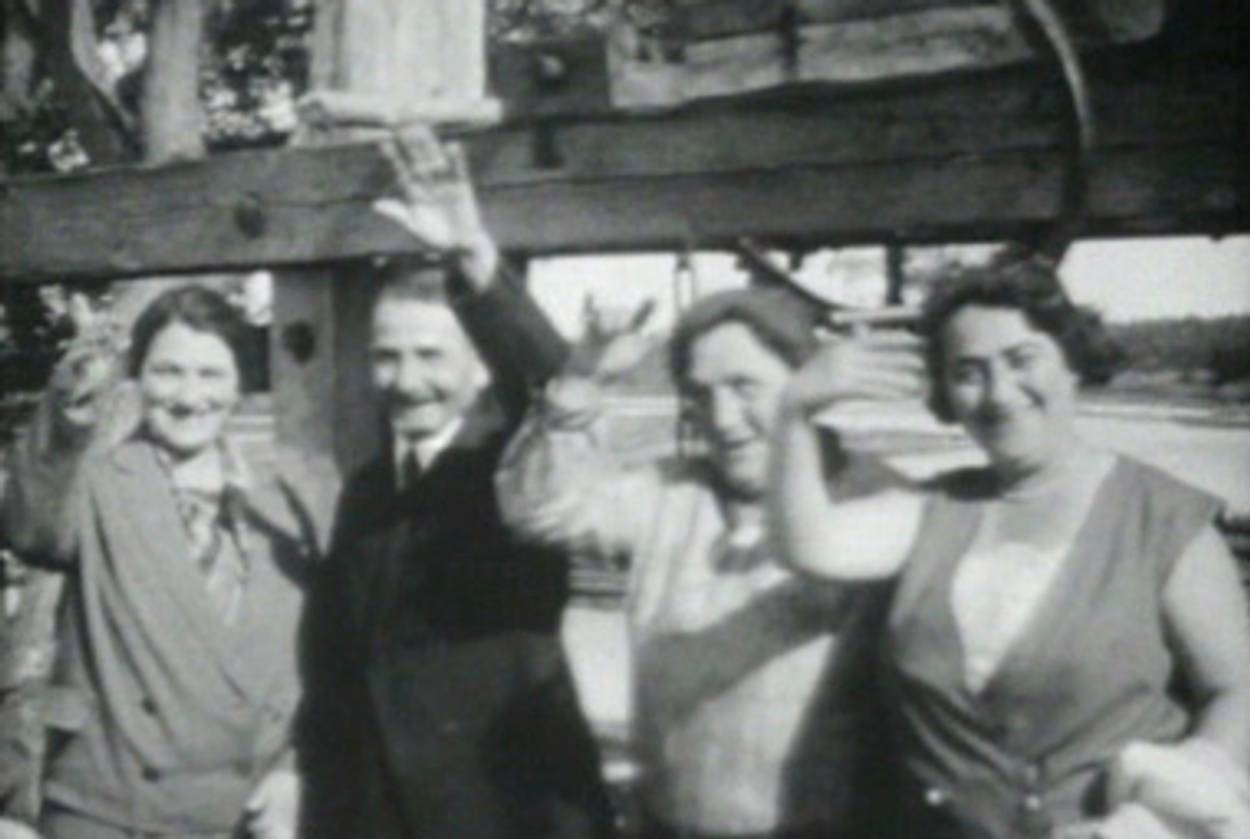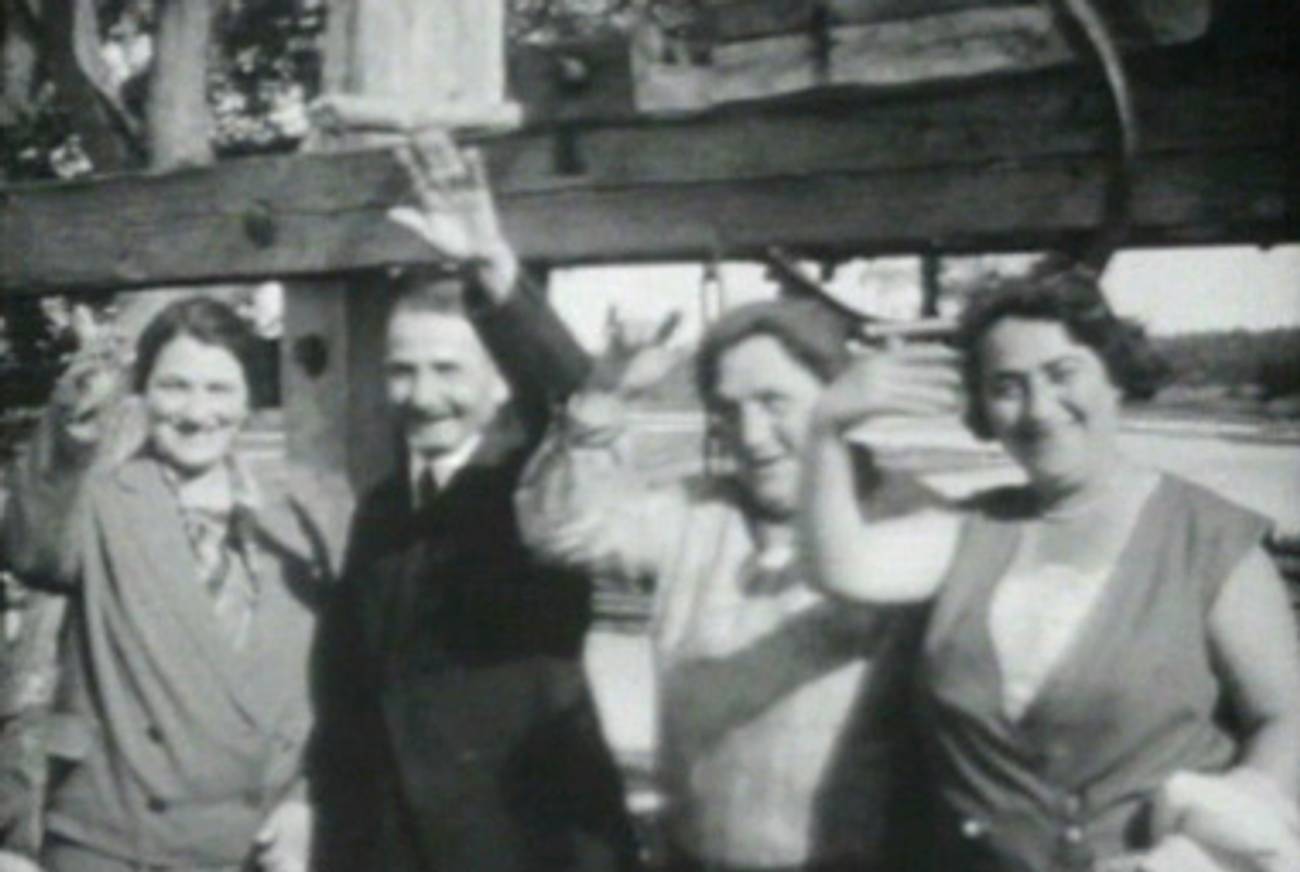Homecomings
A museum exhibition and a new translation from the Yiddish examine ‘heritage travel’ in the 1930s




Immigrating to the United States is a very different prospect today than it was a century ago. Thanks to cheap air travel and long-distance telephone calls, not to mention email and Skype, the decision to leave the old country behind no longer means a total break with the past. While every immigrant’s journey still involves a kind of trauma—starting a new life in New York means dying to the old life in Mumbai or Mexico City—at least it does not mean that you will never see your parents’ faces or hear your friends’ voices again.
“16 mm Postcards,” a new exhibition produced by the YIVO Institute for Jewish Research and the Yeshiva University Museum, at the Center for Jewish History, demonstrates how different things were in the early 20th century, when the ancestors of most American Jews came here from Eastern Europe. This extraordinary show consists of home movies—all silent, mostly fragmentary—taken by American Jews who visited their relatives in Poland in the 1930s. (Many of the films can be seen at the exhibition’s website.) What makes these films so powerful is their extreme rarity: It was only a small handful of Jews who had the wherewithal, and the desire, to go back to the villages they had left behind decades earlier. And the encounters they document show how drastically the fates of American and Polish Jewry had diverged by the 1930s. In many films, we see the American cousin, prosperous and dressed in a Western suit, standing next to his poor, bearded, caftanned relatives; and it is impossible not to wonder what must have been going on in their minds and hearts.
Did the American cousin, clutching his camera like a badge of modernity, give thanks that he had been rescued from ancestral poverty and anti-Semitism—or did he feel nostalgia for the Jewish world from which he was cut off? Did the Polish cousin envy his American relative, or resent his intrusion, or long for his help? The pathos is infinitely greater, of course, because the viewer knows that all these Polish Jews—old and young, men and women and children—are just a few years away from the Holocaust. Virtually none of the people we see in these home movies was alive 10 years later. Because of the Holocaust, the natural growing-apart of the Old Country and the New World became an irreparable break, and a source of permanent guilt. Jews who came to America lived and flourished, while those who remained behind suffered and died: How can such a gulf ever be crossed?
The questions that “16 mm Postcards” raises, silently and by implication, are addressed head-on in a new book that might serve as a companion to the exhibition: The Glatstein Chronicles (Yale University Press). This is the title given by the volume’s editor, Ruth Wisse, to two novellas published by the great Yiddish writer Jacob Glatstein in the late 1930s, based on his own pilgrimage to the Alte Heym. Glatstein was born in Lublin in 1896 and came to New York in 1914. After working for a time in sweatshops, he established himself as a Yiddish journalist, while writing poetry that brought the influence of Joyce, Eliot, and Pound to bear on Yiddish literature. “The term experimentation,” Wisse writes in her introduction, “hardly suffices to describe the many subjects that Glatstein addresses, the poses he adopts, and the poetic variations he attempts.”
In 1934, Glatstein received word that his mother was dying in Poland and booked passage across the Atlantic to see her one last time. This journey provided the subject matter for two books that he published after his return to New York. The first, whose Yiddish title literally means “When Yash set out” (Yash is a nickname for Yankev, or Jacob), is rendered here as Homeward Bound; the second, “When Yash arrived,” is made into Homecoming at Twilight. A third volume was announced, but never written: “the ‘Yash’ scheme was conceived as filial homage to Polish Jews,” Wisse writes, “and did not survive their destruction.”
In fact, as the word “twilight” in the English title suggests, Glatstein was very conscious of writing about a Jewish community in decline. Homeward Bound opens on board the ship taking Yash and a motley group of fellow-passengers to France, and the first sentence speaks of the narrator’s sense of liberation: “No sooner did the ship pull away from the dock than I instantly felt myself subject to maritime law.” Yet it is clear that this freedom is only a temporary escape from the crises and factionalism of Jewish life: “But these past few years my mind is mired in the bloodstained world of politics. ‘I think, therefore I am’ is no longer enough. Am what? One must legitimate oneself by announcing a political creed: I am a liberal, a Fascist, a Social-Fascist, or a Communist, a Trotstkyite, a Lovestonite, a Zionist.”
In fact, politics quickly intrudes on the floating world of the ship, when the narrator reads in “the ship’s newspaper that Hitler had done away with his closest associates in the so-called Night of Long Knives.” (This infamous purge of the Nazi Party took place on June 30, 1934, allowing the story to be precisely dated.) The news reveals a fault line among the ship’s passengers, Glatstein observes. To the non-Jews, it is merely another news item, to be casually regretted or dismissed (“Hitler’s a damn fool!”). To the Jews, on the other hand, it is a terrible portent, and it drives Glatstein to seek the company of people who will understand his own sense of dread: “The casual reaction of my Gentile fellow passengers to the Hitler news was the first slap in the face I had received as a Jew on this floating international paradise.”
Cannily, Glatstein uses this minor episode to suggest the organizing principle of Homeward Bound. There is almost no plot, simply a series of encounters with his fellow passengers, in which he allows them to hold forth about their experiences and ideas; and in the course of these interviews (in this story, Glatstein the journalist dominates), we are given a panorama of Jewish existence at a historical turning point. We meet an assimilated Dutch Jew, who goes on and on about how he is a Dutchman first, a Jew second, and complains about the bad image of poor Jewish immigrants in Amsterdam. (“I swear, I turn red in the face whenever I see a Polish Jew. Why must they always attract attention to themselves …?”)
Then there is a hard-living Jew from Bogota, who complains about the difficulty of finding a Jewish wife there, even as he brags about his beautiful Colombian mistress. (Here, as throughout The Glatstein Chronicles, the sexual frankness is surprising: “The truth is that these gorgeous women are useless in bed, cold as icebergs. They just lie there, like royalty.”) And there is a Soviet Jewish engineer, who is embarrassed when Glatstein compliments him on his “Yevreskaya golova, a Jewish head!”: This kind of ethnocentrism is taboo in the worker’s motherland. Ironically, the Soviet Jew’s socialist universalism makes him a mirror image of the Dutchman who shuns his Jewishness. “Aboard ship it’s easier to appreciate the individual’s worth,” Glatstein writes, and he creates a wonderfully vivid gallery of eccentric portraits. Taken together, however, they show the inescapability of “the Jewish question,” the way it turns individual Jews, even against their wills, into a collective.
Homeward Bound ends with Yash’s train arriving in his hometown, as the conductor cries, “Lu-u-blin!” But when Homecoming at Twilight begins, we are surprised to find that the key event—the deathbed reunion with his mother, the whole reason for the trip—has been skipped over. Such a disorienting elision signals that, in the second novella, Glatstein the modernist will preside: The straightforward interviews of the first story give way to a collage of dreams, memories, and parables. The setting this time is a resort hotel, where sick and exhausted Jews (including a few mental patients) come to recuperate. It is, as Wisse points out, a parody of the Alpine sanitarium in The Magic Mountain (which was translated into Yiddish by Isaac Bashevis Singer); and there are so many echoes of The Castle that it seems Glatstein must have been reading Kafka as well.
Once again, Glatstein’s subject is the state of Jewry, as seen through conversations with different types of Jews. But this time his focus is strictly on Poland, and the people he meets seem like archetypes of Polish Jewish experience. There is the dying Steinman, a charismatic Zionist who knew Herzl: “I burst into tears when I was face to face with him. I’m not ashamed to admit that I kissed his hand.” There is the brilliant young son of a Hasidic rebbe, who seems destined to become a new Nachman of Bratslav: “Some day I’ll read you some of my new ideas, and you’ll see for yourself that they are simply extraordinary,” he says.
But in a montage-like series of interviews with Polish Jews, all asking Glatstein to carry messages home to their American relatives, we are shown how the whole Jewish community is caught in an insoluble tangle of poverty, anti-Semitism, and sheer despair. And America, now mired in the Depression and closed to new immigrants, can no longer offer them hope. All the supplicants are in the same position as the unemployed rabbi who shows Glatstein a yellowed letter he once received from Herbert Hoover, which he imagines will help him get to America. In fact, Glatstein and the reader realize, it is merely a meaningless form letter; the old promise of the New World can no longer be claimed.
By the time old Steinman dies, in a moving scene at the end of the book, he seems to foreshadow the death, spiritual or even physical, of Polish Jewry itself. “It seemed to me now, in the twilight, that I had reached the autumn of my life,” Glatstein reflects. “Even my mother’s death seemed to coincide oddly with the downward movement of my own life, and all this was in step with Jewish life as a whole, maybe even with the twilight now settling down over the whole world.” The Glatstein Chronicles is a remarkable portrait of that twilight moment—not just an invaluable historical document, but a literary work of great subtlety and power.
Adam Kirsch is a poet and literary critic, whose books include The People and the Books: 18 Classics of Jewish Literature.
Adam Kirsch is a poet and literary critic, whose books include The People and the Books: 18 Classics of Jewish Literature.